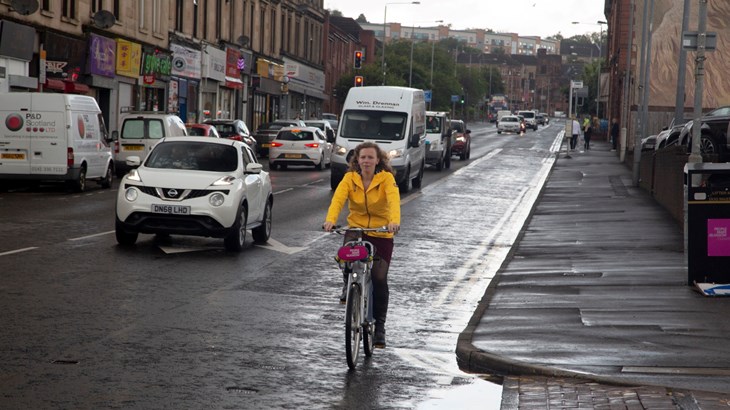Sustrans has worked with partners to inform the Department for Transport’s newest changes to The Highway Code, which now prioritises safety for all and introduces a hierarchy of road users.

Credit: Max Crawford/Sustrans
New changes to The Highway Code mean that those walking, wheeling and cycling are now recognised as the most vulnerable road users, making their safety of paramount importance.
These changes apply to only England, Scotland, and Wales.
These changes to The Highway Code include:
1. New hierarchy of road users
The new hierarchy of road users ensures that those who can do the greatest harm have the greatest responsibility to reduce the danger they may pose to others.
At the top of this hierarchy (as most vulnerable) are people who are walking, in particular children, disabled people and older adults.
Therefore a person cycling assumes responsibility to look out for the safety of those walking.
In the same way, a driver has responsibility for those walking, wheeling, cycling and horse riding.
2. Dutch Reach
The Highway Code will now advise people to use the Dutch Reach method when getting out of a vehicle or when opening a vehicle door from within.
In practice, the Dutch Reach is simply the act of opening a vehicle door by using the arm which is closest to the centre of the vehicle when seated.
This action causes the person inside the car to look over their shoulder and out of the window to check for other nearby road users.
This simple habit will help to reduce the likelihood of the dangerous event that's known as 'car dooring'.
In turn, this will reduce the risk of injury to people walking, wheeling, cycling and motorbiking.
3. People crossing the road at junctions have priority
When people are crossing or waiting to cross at a junction, people driving, riding a motorcycle or cycling should give way.
If people have started crossing and traffic wants to turn into the road, the people crossing have priority and the traffic should give way.
4. People driving and riding motorcycles are to give way at junctions to people on cycles or horses
The Highway Code will now state that at a junction, people in vehicles who want to turn should not cut across people who are travelling straight ahead on cycles or horses.
This applies whether there is a cycle lane in place or if a person is travelling on the road. Drivers about to turn into a junction or side road should also now give way to pedestrians crossing or waiting to cross.
5. Safer passing distances for overtaking people cycling and horse riding
People driving are now instructed to leave a distance of at least 1.5 metres when overtaking people who are cycling or horse riding.
And at least two metres are required when overtaking people who are walking on roads without pavements.
The importance of feeling safer
On these changes, Sustrans CEO Xavier Brice said:
“Sustrans has worked hard with partners to inform these amendments.
“They're based on the crucial aims of improving safety at junctions and making passing distances safer when people in vehicles are overtaking those who are walking, wheeling, cycling and horse riding.
“We must all continue to look out for each other as we travel and this new hierarchy at last recognises that road users with the potential to cause the greatest harm have the greater responsibility.
“We know that when people feel safer they are more likely to choose active forms of travel, such as walking, wheeling and cycling, and so Sustrans strongly supports the UK Government’s decision to amend The Highway Code.”
The myths and facts of the Highway Code changes
Myth: Only drivers are expected to be considerate
Fact: The new “hierarchy of road users” makes the point that quicker and heavier modes of travel should be especially careful for those who are more vulnerable.
Horseriders should be careful for cyclists, and everyone should be careful for pedestrians, and be particularly careful for children, older people or disabled people.
Myth: Cyclists are now being ‘allowed’ to ride in the middle of the road
Fact: Using the ‘primary position’ has been advised in the Highway Code for years. Cyclists should use the centre of the lane to make themselves more visible at narrow sections of roads, when approaching junctions, or generally at any point where a car overtaking would cause danger.
Myth: There’s a new rule saying cyclists do not have to use cycle lanes
Fact: Cyclists are already not obliged to use bike lanes when one is provided. The language has been made clearer, saying cyclists “may exercise their judgment and are not obliged to use them”.
Myth: Pedestrians can cross roads at any time
Fact: Drivers about to turn into a junction should now give way to pedestrians “crossing or waiting to cross”. The previous version said pedestrians had priority only “if they have started to cross”. Crossing the road can be daunting, especially for older people or those with small children.
Myth: Cyclists are now allowed to ride two abreast
Fact: The old version said cyclists should “never ride more than two abreast, and ride in single file on narrow or busy roads”, which was vague.
The code will now say: “You can ride two abreast and it can be safer to do so, particularly in larger groups or when accompanying children or less experienced riders.”
Myth: Drivers shouldn’t be expected to know this
Fact: Recent coverage has focused on supposed confusion and ignorance. Many of the changes amount to good sense and common courtesy.
However, other elements (riding two abreast), have been in the Code for years but are still routinely unknown to drivers.





